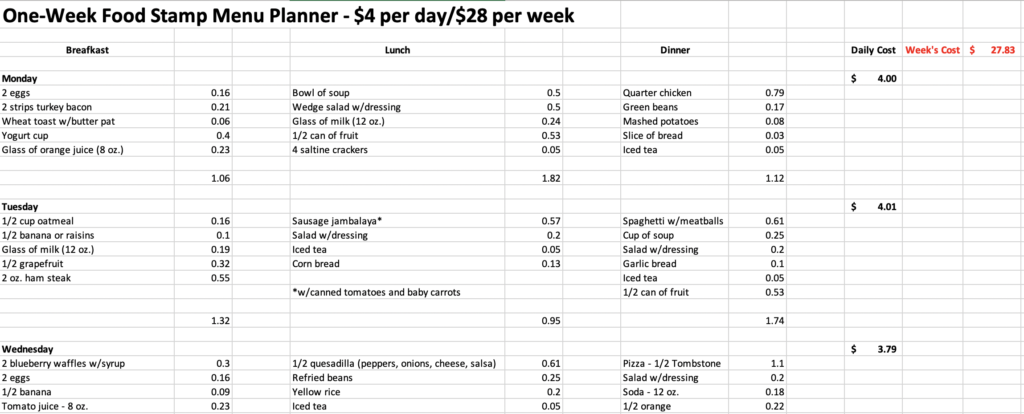
Download and check out this 7-day menu planner (Excel spreadsheet) that shows you how I created 21 filling meals for $4 per day, or $28 per week.
Oh, and there’s no Ramen!
FSC Weekly Meal Planner

Download and check out this 7-day menu planner (Excel spreadsheet) that shows you how I created 21 filling meals for $4 per day, or $28 per week.
Oh, and there’s no Ramen!
FSC Weekly Meal Planner
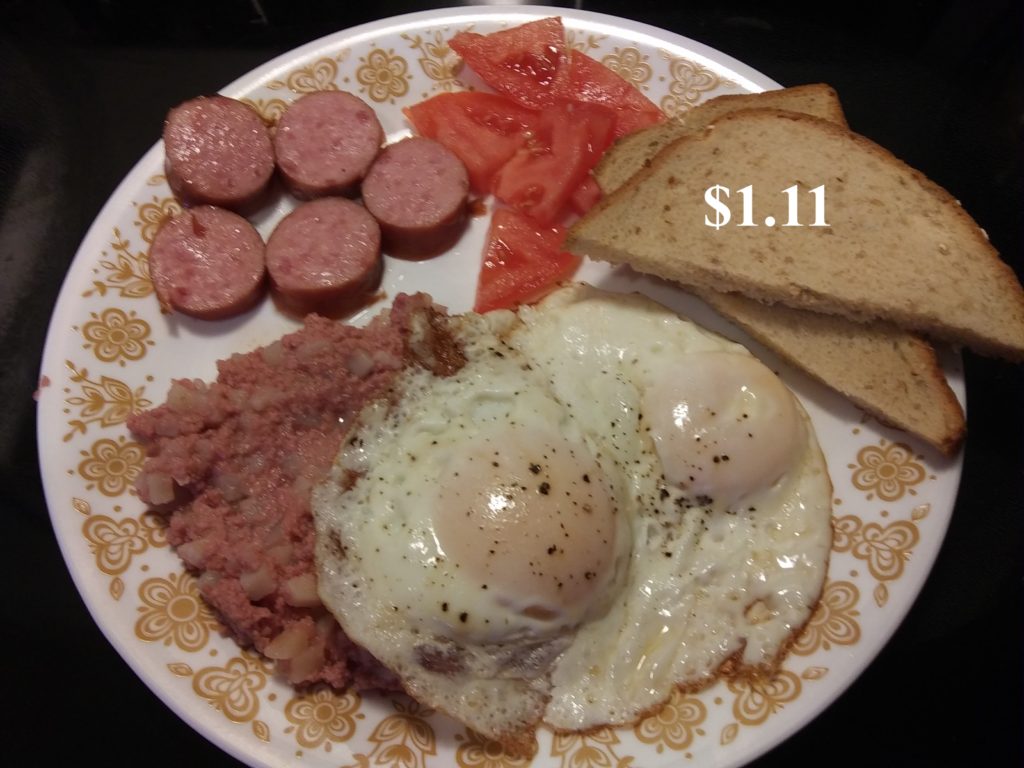
Eggs vary from 5¢ each to 10¢ each, depending on when and where you get them.
44¢ – 1/4 can hash ($1.75/can)
16¢ – 1/8 smoked sausage ($1.99)
20¢ – tomatoes
12¢ – 20¢ – eggs
13¢ – 24¢ – 12 oz. glass of juice (I cut mine with water to reduce calories and sugar)
3¢ – toast
This is a quickie made in the microwave.

Two eggs will cost anywhere from 5¢ to 10¢ each depending on where you live.
Ham is expensive. This package of ham (pictured) normally costs $13 at Kroger. I saw three large packs on sale for $3 each and bought them, put one-third of each pack into a sandwich bag and put them in the freezer.
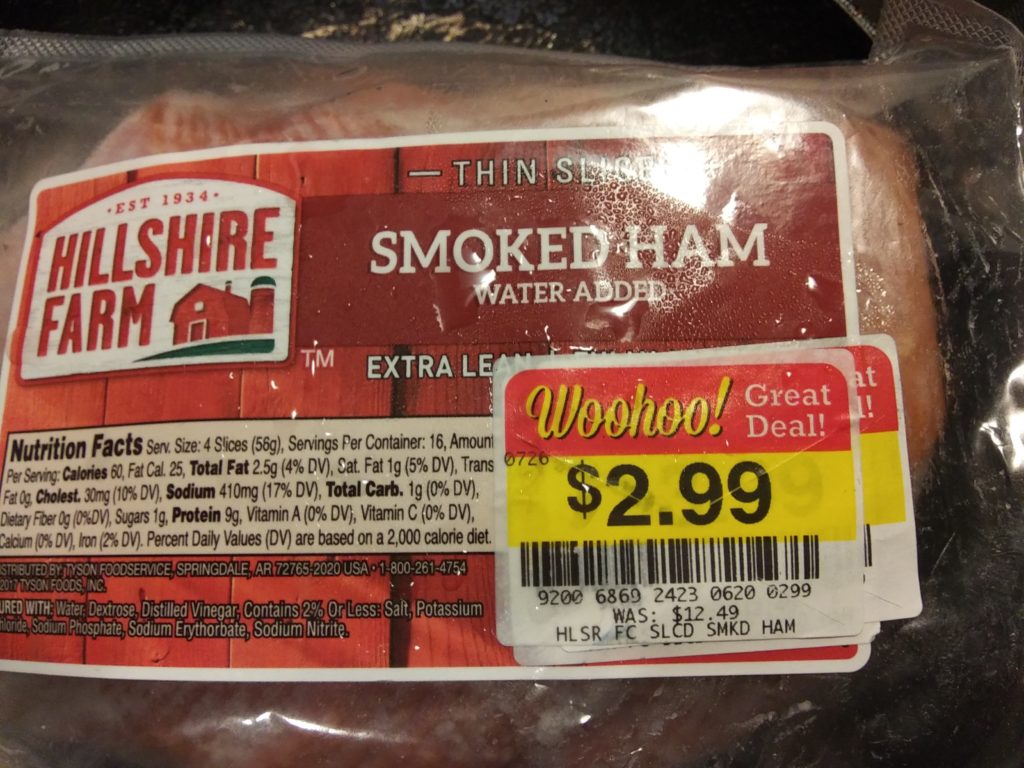
I got $30 worth of free ham! At this price, it came down to 5¢ a slice for the ham instead of 20¢ each.
A few weeks later, I saw 20 lb. hams – regularly $60 each – on sale at Kroger for $8 each! I cut one up, put into freezer bags, and how have affordable ham for months.
I get one to two coupons for cheese from Kroger every month.
If you buy bread from the day-old (more like several-day-old) rack, it’s 3¢ a slice.
Milk at $1.99 a gallon in 13¢ for an 8 oz. glass.
Lots more cheap breakfast ideas at this page.
If you’re cutting back on the amount of protein you eat, especially animal products, make sure you pick the healthiest proteins to meet healthy eating and weight-management goals. Here are some suggestions for getting good nutritionnal value when you eat proteins.
The cheaper the cut of beef, the lower the fact content, except for hamburger. Cheaper beef isn’t as tender as more-expensive cuts, so learn how to cook flank steak, sirloin and skirt steak and you’ll be able to enjoy beef with less saturated fat. If you marinate and slow-cook cheaper cuts of beef, they’ll turn out tender and delicious.
As we shared with you in a previous blog post, all seafood is not created equal. Coldwater fish are your healthiest choices, providing you with more lean protein and omega-3 fatty acids. Choose wild-caught salmon over farm raised if you have the option. Don’t worry about the cholesterol in shellfish – dietary cholesterol isn’t the kind that gets into your arteries. Enjoy delicious garlic shrimp with your pasta instead of ground beef or sausage.
Choose white mean, especially breast meat, when eating bird. Don’t assume the pre-made turkey burgers are as low in fat as they can be. Better to buy ground turkey breast and make your own patties than to buy pre-made patties made from dark meat. Free-range and organic chicken is becoming more available and affordable, and even big-name chicken producers reducing the amount of additives they are putting into their chickens and turkey.
Pork can be a leaner alternative to high-fat beef, but choose low-fat, low-sodium cuts and organic varieties. Here’s an interesting comparison between pork loin and chicken by The Food Network.
With the good news about dietary cholesterol no longer being a nutrient of concern, it’s OK to increase your intake of eggs. They’re a great source of lean protein and healthy fats. Add them to salads. Make egg salad with low-fat mayo.
Milk has many health benefits, but like most other foods, if you consume it every day, it can have some downsides. If you Google the subject, you’ll find many opponents who dispel all of the health benefits of drinking milk (e.g., it doesn’t improve bone health, and high consumption can increase the risk of some cancers) and recommend we stop drinking it altogether. Other experts stand by the health benefits and suggest we drink it every day.
One surprising study recently suggested that whole milk is actually better for weight loss than skim milk because the fat in whole milk satisfies our hunger better and reduces ensuing sugar cravings. However, the USDA suggests Americans drink low-fat and fat-free milk – but even low-fat milk still has lots of calories. If you drink the USDA’s recommended daily servings of milk, you’ll add more than 360 calories to your daily intake.
This helpful Weight Watchers article provides information that may calm your fears about growth hormones in milk and beef. This CBS article might also calm your fears about antibiotics in your milk.
Finally, depending on your racial heritage – primarily if you’re of Northern European descent – you will become less able to digest lactose (a sugar found in milk) as you age.
If you’re worried about milk, try almond or soy milk, and make sure you’re eating other foods that give you plenty of calcium, potassium and vitamin D. You can also add calcium-fortified orange juice and vitamin D fortified foods to your diet.
When choosing dairy products, think quality, not quantity, in your servings. For example, when you make a pizza, don’t layer on the cheese until you can’t see the tomato sauce. Experiment with your next several pizzas to see how little cheese you can get away with – you might be surprised at how gooey and delicious a pizza can be with half the cheese you normally use.
If you use butter as a bread spread or cooking additive for recipes, consider a butter substitutes. Now that trans fats are being phased out, you don’t have to worry about the problems associated with margarine. Choose one that’s lower in saturated fats and calories. Some contain plant sterols that can improve your blood cholesterol.
If you regularly eat yogurt as a meal replacement or snack, remember the best-tasting ones are the sweetest, and that means more sugar. Check labels and look for Greek yogurt. Look for other healthy protein sources, such as unsalted mixed nuts, nut butters or seeds, as substitute snacks.
If you’ve got a sweet tooth, take some time to research frozen desserts. Check out the nutrition labels on ice creams, frozen yogurts, sorbets and sherbets. Cut your servings in half, but add some crushed almonds or walnuts (be careful about portion sizes, nuts are calorie-dense foods), or a small amount of fresh fruit or berries to help you satisfy your craving for a creamy frozen dessert while reducing the amount you eat.
Nuts and seeds are a healthy source of lean protein and good fats that can help you feel satisfied longer after a meal or snack. They are calorie dense, so a little goes a long way toward satisfying hunger. They can also help improve blood cholesterol and reduce the effects of inflammation. Adding almonds, cashews, walnuts and Brazil nuts to stews, casseroles, salads and stir-fries is a great way to add healthier proteins to your diet.
Peanut butter is the hands-down favorite nut butter among consumers, but almond butter provides more healthy fats, vitamin E, and calcium and magnesium. Almond butter is more expensive than peanut butter, especially cheaper peanut butter choices that have added salt, sugars and fats. You can also get your almonds in the form of almond milk.
While not as nutrient-packed as almond and peanut butter, cashew butter is a close third in most categories and provides more iron and zinc than the other two. If your family doesn’t like the taste of almond butter but enjoys cashew butter, add it to your diet.
Keep a jar or shaker of seeds handy to sprinkle on salads, in stir-fries and on desserts. In addition to being a good protein source, seeds contain healthy fats and are a good source of dietary fiber. Refrigerate or freeze seeds to help them last longer.
Like corn, soy is creeping into to many processed foods. That’s because it’s fats help create good food textures. At one time, expert thought soy was going to be the food that helped feed the planet, but many people are allergic to soy, with reactions including an itchy throat, watery eyes and sniffles.
There are also concerns about how it’s genetically modified. However, if you’re not allergic to soy, foods like edamame, tofu, tempeh, miso and soy milk can help you add protein to your diet as an alternative to animal sources.
Unfortunately, there’s conflicting information about the health benefits or problems associated with eating soy and soy products. Talk to your doctor or a registered dietitian if you need to add a protein source to your diet and are considering soy, especially if you are pregnant.
Other beans and legumes are packed with healthy protein and provide different vitamins and minerals, as well as dietary fiber. Add beans to soups, salads, pasta dishes and stews if you want to cut down on animal product ingredients. Beans are not complete proteins, providing all of the enzymes you need for good health, but when you combine them with rice, you get a complete protein dish.
You’ve probably noticed that packages of ground beef in your supermarket case have different names and prices, but do you really know what they mean? Here’s a quick guide to helping you buy the healthiest and tastiest choices of ground beef, rather than just shopping by price.
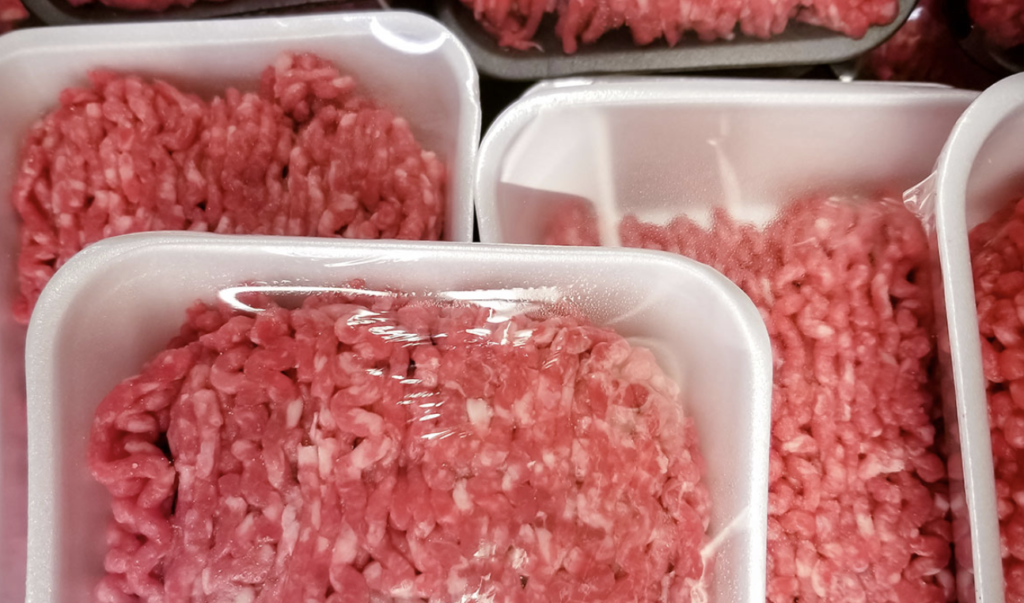
The main difference between ground beef types is the fat content. When buying whole beef cuts, the cheaper the cut, the less fat it has. The opposite is true when buying ground beef. The cheapest packages have the most fat.
Here’s a quick guideline showing the approximate lean-to-fat ratios of different types of ground beef:
•Lean Ground Beef – 95/5
•Ground Sirloin – 90/10
•Ground Round – 85/15
•Ground Chuck – 80/20
•Hamburger/Ground Beef – 73/27
Meat labeled as “hamburger” or “ground beef” can come from almost any part of the cow. Ask your butcher what the grind contains and if it has the chemical filler “pink slime.” You might even find that today, based on what the store needed to get rid of, the hamburger is made from filet or ribeye!
When you buy ground beef for making hamburgers, you might be tempted to buy the leanest choice. You’ll see on the label a percentage, such as “90% lean.” The problem with very lean ground beef is that the low-fat content makes it more dry. This is fine if you’ll be covering the beef with spaghetti sauce or using it in tacos that will be covered with lots of toppings.
If you want a juicy hamburger, however, your best bet will be ground chuck, an 80/20 grind. This is the mix many top restaurant chefs use for their high-end burgers.
In our blog post, Whole Foods & Organics: Worth the Cost?, we noted that not all natural fruits and vegetables are worth the high price. Organic beef, on the other hand, is a much healthier choice than commercially raised beef. This is because mass-produced beef often contains antibiotics, growth hormones and other chemicals.
These cows are also not grass-fed, and some of the commercial food they eat are grown or treated with commercial fertilizers and pesticides. In some cases, the food these cows eat includes the unusable parts of other cows that remain after their processing (cannibalism)! Organic, grass-fed beef also contains more heart-healthy Omega-3 fatty acids. Look for lean, natural, organic, grass-fed beef if you want the healthiest option for yourself or your family.
When serving beef, you can reduce calories by using the meat to flavor dishes that feature plenty of other heart-healthy ingredients. For example, instead of a half-pound hamburger, make a smaller patty and dress it with thick slices of ripe tomatoes, caramelized onions, sautéed mushrooms, crunchy greens and just one slice of low-fat cheese.
Don’t Reduce the size of the bun without skimping on the quality of the bread – make the bread an important part of the flavor combination. Choose Flatout flatbreads or Foldits to make delicious burger wraps or sliders you pair with healthy side dishes or a bowl of low-fat vegetable soup.
Serve kids Sloppy Joe sliders (instead of large sandwiches) with baked sweet potato fries and a light Cole slaw. Turn a bowl of baked beans into a main course by adding some ground beef and flavoring the dish with a bit of brown sugar, dry mustard and catsup.
When making spaghetti sauce, make large pieces of carrots, onions, mushrooms, green peppers and other veggies the stars of your marinara, adding just enough lean ground beef to add that familiar flavor you want. Check out these 11 healthy ground beef recipe ideas that come in at 300 calories per serving or less.
If a butcher, deli or meat department at a grocery store advertises that they grind their hamburger fresh every hour, be careful. Many, if not most, of these meat purveyors do not break down and clean their meat grinders after each grind. That takes too long.
This means that beef that sticks in the grinder at 8:00 am might still be there hours later, sitting in the open air at room temperature. The Centers for Disease control estimates that 265,000 Americans get E. coli infections each year. While not all of these infections are caused by ground beef, ground beef recalls due to E. coli are common in the news.
You know how good fresh ground coffee tastes – why not do the same with your beef (or turkey or chicken)? You not only get fresh ground beef, you also control the meat it comes from. To get the freshest ground beef, buy your own grinder and prepare your own.
You can purchase a hand meat grinder inexpensively, or use our awesome technique for getting one free! Before grinding your beef, put it in the freezer for 15 minutes to make it firmer and keep the natural juices from running out during the grinding process. Here are some helpful tips on home grinding from the Weber grill company.
Most people know that eating fish adds a healthy, lean protein to your diet. Doctors, dietitians and other health and wellness experts recommend adding fish to your diet two to three times per week. But not all fish is equally healthy, and the kinds of fish restaurants serve as healthy options are actually the less-healthy choices.

Fish live in either warm or cold waters. Those that live in cold water have higher amounts of the healthy Omega-3 fatty acids you want. These include salmon, tuna mackerel, sardines, lake trout and herring.
Unfortunately, many restaurants are pushing tilapia as their healthy seafood alternative to a burger or pizza. Like catfish and some other warmwater fish, these contain higher amounts of Omega-6 fats, which might increase your risk for heart disease.
So, is eating tilapia worse than having a bacon cheeseburger? Probably not, but if you’re going to eat fish on a regular basis, stick with coldwater choices.
Another thing to look for when buying fish is whether it’s farm raised or wild caught. Producers of farm-raised fish claim their product is raised in clean water and fed healthy fish food. Others say farm-raised fish contains antibiotics and other harmful ingredients. If you like salmon, try farm-raised and Pacific wild caught. If you like the wild caught, it’s probably a good idea to stick with that choice.
Can you believe how many different brands and bottles of fish oil you see on your grocery store shelves these days? And what’s the difference between each one? Unfortunately, shady marketers are putting “1,000 mgs of fish oil” on virtually every bottle, which sounds like the pills provide your commonly recommended daily dose of Omega-3.
The deception comes from the words “fish oil.” A pill with 1,000 mgs of fish oil might contain as little as 30 percent Omega-3. That means you have to take four pills to get 1,000 mgs of Omega-3. And what’s in the rest of the pill? Potentially harmful toxins, extra fat and other impurities.
Look for fish oil pills that have 1,000 mgs of Omega-3 (EPA and DHA) or up to 3 grams per day (talk to your doctor about your needs). Pills with an enteric coating are easier to digest and prevent fish burps.
Protein is overrated.
With the (slow) death of low-carb fad diets and recent scientific discoveries about the role fats play in our good health, people are re-thinking how much protein they need and want to eat.
Yes, protein is a very important nutrient and provides a variety of health benefits, but more and more credible health agencies, organizations and experts are recommending that protein, as a percentage of your daily calories, should be your third-most important macronutrient behind carbohydrates and healthy fats.
Cutting back on animal products not only helps you spend more of your food budget on fruits, vegetables, grains, nuts and seeds, but also helps reduce unhealthy ingredients in your diet and avoid adding extra pounds.
Instead of serving meat-free meals, reduce portion sizes and put more effort into creating tastier and nutritious side dishes. Just because someone loves the taste of beef or chicken doesn’t mean they need a large serving. When people can fill up on a delicious multi-food meal, they won’t miss a few extra ounces of steak or turkey.
Aim for portion sizes no larger than the palm of your hand. People will finish a large glass of a drink rather than pour part of it down the sink and waste it, so you might be serving more each meal than you need. When serving milk, shoot for an 8 oz. glass instead of 12 oz. or 16 oz. serving.
One way to help your family enjoy smaller servings of beef, chicken, pork and other animal proteins is to serve your meal in courses. Having a salad or bowl of soup, along with something to drink before the main course arrives, starts the process of feeling full earlier.
After someone has eaten soup, salad bread and had a drink, they won’t be “starved” for a big piece of meat and lots of starchy potatoes and vegetables. Penn State researchers found that people who had soup before their main course ate 20 percent fewer calories at the meal.
If you serve a traditional meat-and-two sides meal (protein plus two vegetables), the animal protein you serve usually needs to be the star of the meal. To reduce the amount of meat people want, create stir-fries, stews, chilis, pastas and other dishes that add meat to main dish, rather than make protein the main dish. You’ll taste beef or pork or chicken most forkfuls, but won’t consume as much.
When you buy animal products, choose healthier versions, such as free-range eggs, organic meats and low-fat dairy products. Some research suggests that full-fat milk is actually a better weigh-loss choice than skim because it’s more satisfying and reduces cravings later.
Whichever animal products you choose, read labels to avoid artificial ingredients. Choose less-expensive cuts of beef, which contain less saturated fat, and learn how to cook these cuts low and slow for maximum tenderness and flavor.
To make sure you make up for the iron and calcium you lose when cutting back on animal products, make sure to choose healthy, complex carbohydrates. Buy whole-grain pastas and breads rather than refined wheat versions. Choose sweet potatoes over white and brown rice over white. When it comes to vegetables, eat the colors of the rainbow for maximum health.
Make sure to get enough iron, vitamin D and calcium in your diet when you cut back on animal products. Iron-rich foods include soybeans, lentils, sesame seeds, garbanzo beans, lima beans, olives, navy beans, navy beans and Swiss chard.
To get more calcium, eat tofu, sardines sesame seeds, yogurt, collard greens, spinach and turnip, mustard and beet greens. Look for iron-fortified cereals and calcium-fortified orange juice. Vitamin D is not present in many foods – our body processes vitamin D from sunlight, using our skin (the body’s largest organ).
That’s why so many foods, especially cereals and dairy products, are fortified with vitamin D. To get more vitamin D in your diet, eat salmon, sardines, tuna and eggs. Talk to your doctor about taking a vitamin D supplement, based on your eating habits.
If you’re not quite sure what’s going on with the all of the name brand, generic, store brand and private label items you’re seeing in grocery stores these days, you’re not alone.
As this trend continues to grow, it’s a good idea to know what’s what when it comes to your food, snacks, household items and pet foods, and whether or not you can really save money without sacrificing quality by purchasing non-brand items.
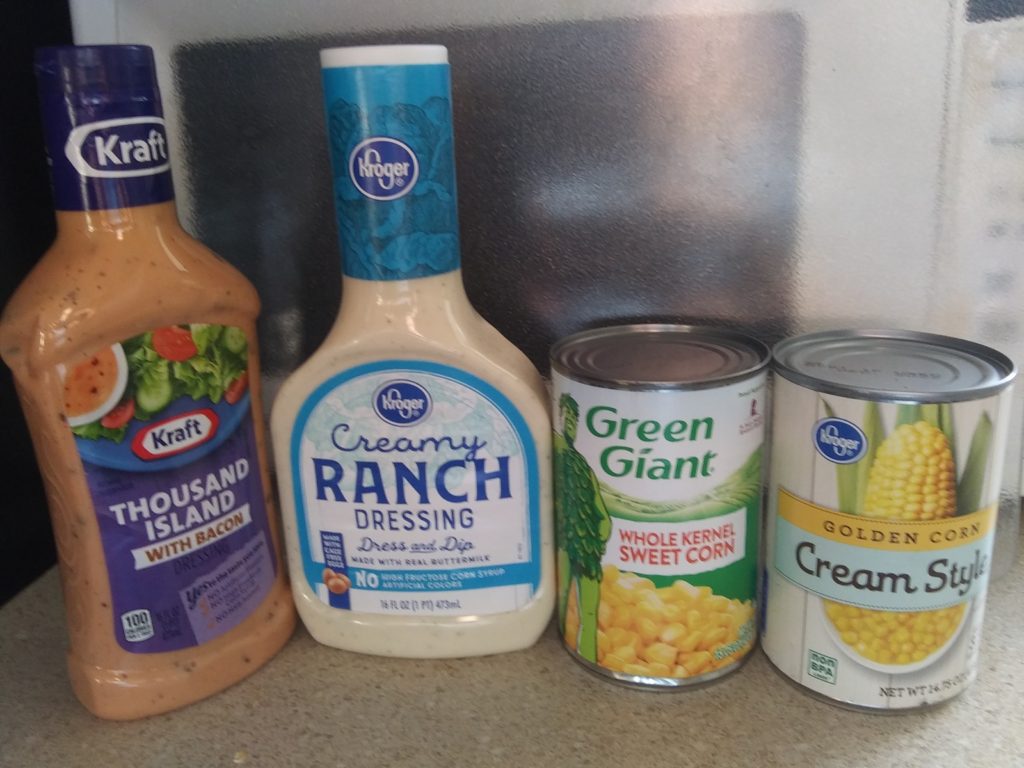
Generic items are those that are sold with virtually no advertising or promotion, and even limited label design. These products might be made by food manufacturers who sell them to multiple chains, varying the label slightly. They might feature fewer conveniences, such as pop-top can lids or resealable packages.
Generics and house brands can cost up to 75 percent less than branded items, but that doesn’t mean you can cut your monthly grocery bill by that much across the board. This is because you will naturally want to buy some of your favorite brand items no matter how much less expensive generics are. And, some items might not be available in generic or store brand versions.
If your family spends $500 a month on groceries, you might not be able to cut your bill by 50 percent, based on what products you buy. However, if you only decrease your spending by one-third, you’ll save close to $2,000 annually – which doesn’t include your credit card interest. If you carry your grocery purchases on a credit card with a 20 percent APR for one year, you’ll save another $200 by purchasing non-branded items. Using a few coupons, waiting for sales, using a loyalty card, buying in bulk and joining a buyer’s club will save you even more.
Let’s say you can save $2,000 per year on groceries without reducing the amount of food you buy, or reducing the quality of food you buy. If you had started doing this four years ago, you’d have more than $9,000 in your bank account today, based on how you invested your $2,000. If you put that $2,000 into a 401(k) with a match, you can more than double that figure!
You can find generic items in the bakery, deli, canned goods and boxed item aisle, freezer section, produce section, pharmacy and meat and seafood department. You can also buy household goods, pet foods and just about everything else you regularly buy.
Brand name items include products such as Green Giant and Del Monte vegetables, Coke and Pepsi, Kellogg’s and Post cereals and Eveready and Duracell batteries. These companies spend considerable money on advertising, coupons, promotions, celebrity endorsements and other promotions and must add every promotional dollar they spend to the price of the product.
Store brand items are those that are sold under a chain’s name, and they are not available in other stores. Private label items are made for a store, but don’t carry the store’s name. These products are made for the grocery chain by a dedicated food manufacturer, meaning the grocery store does not have a manufacturing plant to make its own goods.
Store brands usually come with some promotional spending, such as in-store signage, special mentions in circulators or special packaging.
Grocery stores that sell generics and store brands do not buy their own farms and open their own canneries. They buy from food companies that don’t have their own brands and make products for many companies – sometimes even competitors. Non-branded food items are made by companies that specialize in food production, packaging and distribution, using most, if not all, of the same quality control and manufacturing procedures as large brands. These companies often make specific knock-offs of branded items, which are put on the shelf right next to the original. You’ll notice this most in the cereal aisle.
Why would a grocery store want to sell a generic box of cake mix for $1 when it can sell a brand name mix for $1.80? Because grocers know that some people will always choose the lowest-cost items available, and some shoppers will never buy generics. Offering brands and generics means a store can attract both of these customers.
Can you really tell the difference between name brand spaghetti and generics? How about green beans? If you do some blind taste testing of items such as pasta sauces, cereals and milk, you’ll be surprised that you might prefer many generic versions of your favorite foods, and you most likely won’t be able to tell the difference between items such as General Mills Cheerio’s and the generic version called Oaty Oats.
While couponing, bulk buying and joining a buyer’s club can help you save an extra $1,000 per year or more, you don’t need to do more than buy generics and wait for your favorite items to go on sale to significantly reduce your grocery spending each year.
The best way to decide whether buying generics, store brands and private label items is the best way to go for you and your family is to start small. Buy a few food and non-food items such as milk, toilet paper, bread, lunchmeat or salad dressing.
If you like these items, start looking for more options as you walk the aisles of your grocery store, comparing prices. Be prepared, you will occasionally find a generic item (e.g. refried beans or tomato sauce or cookies) you don’t like, but for the most part, staple items will often taste as good or better.
If items you’re looking at buying aren’t the same size, look for the shelf tags that show you the cost-per-ounce to find out which item is really cheapest.
A big key to remember about buying off-brand items is that saving money isn’t about the 50 cents or $1.00 you save on items, it’s about the percent savings. Remember, saving 30 percent off a $500 monthly grocery bill is $150 X 12 months X credit card APR.
Did you know you can prevent, treat and manage most common diseases and conditions with proper nutrition? Many people wait until they’re sick to visit a doctor, who will often prescribe medication, tests, surgeries or other costly treatments.
Working with a registered dietitian (not a certified nutritionist), you can manage your family’s health much better than you can by waiting for medical help after you’re sick.

While some diseases and conditions are largely genetic, many stem from poor diet, lack of exercise and poor lifestyle habits like smoking, drinking, substance abuse and lack of sleep. Common ailments you can avoid, manage, reduce or even cure with a combination of diet therapy and improved lifestyle habits include:
If your personal trainer tells you her or she is a certified nutritionist, that’s not the same as being a registered dietitian. An RD completes a college degree, then becomes board certified. He or she also specializes in different areas, such as becoming a sports nutrition expert or a Certified Diabetes Educator.
Nutritionists often take only a weekend seminar, online course or other non-accredited course of study. They are generally not allowed, by state law, to prescribe any nutrition-based therapies.
A new designation, Certified Nutrition Specialist, is far more credible than a certified nutritionist, so make sure you know the difference.
A teen girl needs to eat differently than a senior woman. A 25-year-old male athlete has different nutritional needs than a 45-year-old male business executive.
Some health advocates believe most non-traumatic deaths (e.g. plane crash, auto accident, gunshot wound) are either caused by, or their severity is worsened by, poor nutrition.
If you have an annual checkup with a registered dietitian, he or she will learn your family health history, tell you your personal risk for specific diseases and conditions, recommend tests to determine where your health currently stands, and then recommend a specific diet plan for you to follow during the year.
A registered dietitian will also recommend you to a medical professional when necessary, provide recommendations for supplements, specific exercise programs and give you daily calorie targets and a list of foods to add to or eliminate from your diet.
Do you have questions about the Atkins or Paleo diet? Fish oil? A daily vitamin supplement? Eating gluten free? A registered dietitian can tell you which of these are fads and which are helpful.
If you already have a disease or condition, a registered dietitian can help you manage your problem, and in some cases, even eliminate it. You can find a registered dietitian in your area by contacting your family doctor, or using this handy online search tool.
You might think grilling is simply cooking outdoors, but the combination of heat source, tools and proteins we use when grilling can create some easy-to-correct cooking errors. Follow these tips to grill the perfect steak, chicken or burgers this summer.
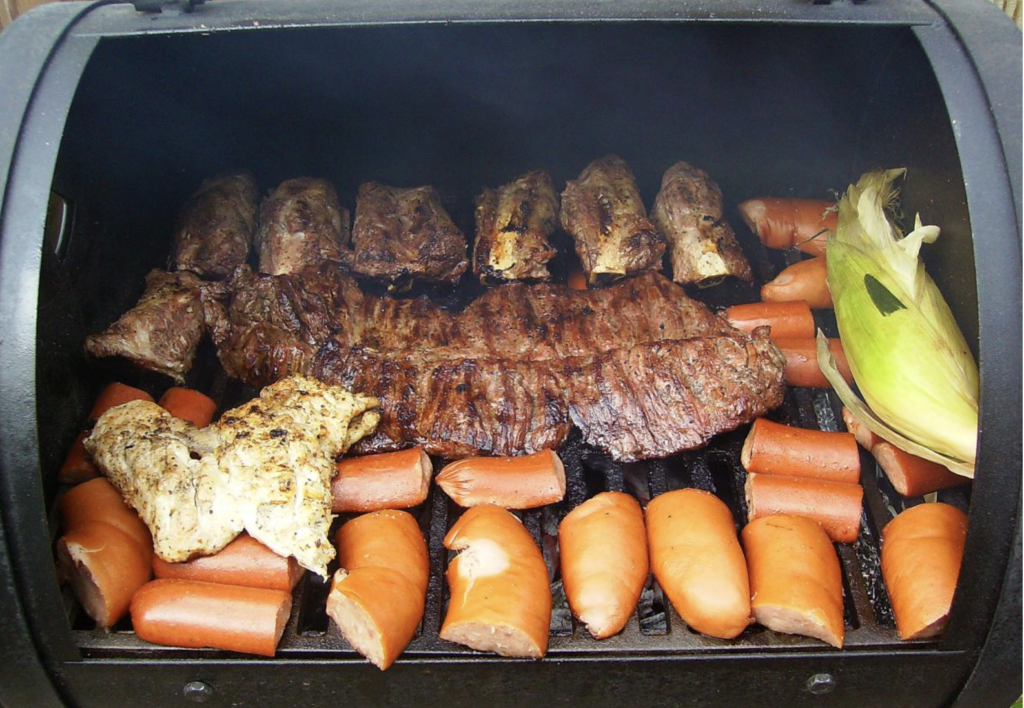
It doesn’t matter how you prep and cook your steaks and burgers if you don’t choose the right beef. The cheaper the cut, the tougher it will be, the lower the temperature you’ll need to use and the longer you’ll need to cook the steak. Good grilling steaks include porterhouse, T-bone, New York strip, filet and rib eye. You can choose other cuts, but make sure you bone up on how to prepare them before cooking, and how to correctly grill them.
You obviously don’t want your proteins sitting in the sun for long periods, but taking them right from the fridge or cooler and putting them on the grill can create a less-than-perfect steak, burger or piece of chicken.
Think about what would happen if you put a frozen steak on the grill – the outside would burn while the inside would remain rock hard. Take your proteins out of the refrigerator or cooler about 15 minutes before you’re ready to cook them to let them get closer to room temperature.
When coals are stacked all the way up to the grill surface, or they are still flaming, you can easily burn your proteins. The Weber Kettle company has an easy test for knowing when your grill is at high heat or medium-high heat. Place the palm of your hand 5 inches from the grilling surface.
If you have to pull it away (because your hand starts to hurt) in less than four seconds, you have high heat. If you have to move your hand between five and seven seconds, you’re at medium heat. If you can keep your hand there for eight to 10 seconds, your grill is at low heat.
When you poke meat or fowl with tongs or forks, juice from the protein runs out of the protein, creating a dryer steak, burger or piece of chicken. Use tongs to place proteins on the grill, turn them and take them off.
Many people press down on meats to help them cook faster or to prevent the inside from being rare. This is probably the biggest reason grilled foods turn our chewy and rubbery. Once you put your steak, chicken or burger on the grill, leave it alone. Prodding, poking, pressing and pushing squeezes juices out of the meat, leaving it drier and tougher.
You can make a steak in one of two ways, in terms of turning it. Place the steak on the grill for one minute to create a sear and seal in the juices. Using tongs, turn the steak over and then leave it alone while it cooks on that side. Let it cook for approximately four to 10 minutes, depending on how thick the meat is, how hot your grill is, and if you want it more rare or well done.
After you’ve let it cook on this side, turn it one more time and finish on the other side to your desired temperature. To get those nice cross-grill marks on a steak, turn the steak sideways from its original position when you flip it the second time.
The other option for turning a steak is to place it on the grill, let it cook for half the time you plan on cooking it, and then turn it over and let it finish on the other side. Remember, when you remove a steak from the grill, it will continue to cook on the inside, especially if you place it under foil while you’re waiting to serve it.
Don’t keep turning hamburgers and don’t use the side of closed tongs to pat, flatten or press chicken. Leave. It. Alone.
When you watch cooking infomercials, you usually see the chef or pitchman take a steak or turkey or pork roast out of the cooking gadget and immediately slice it open. Out runs lots of juice, making your mouth water. But do you really want the juice from your steaks and chicken to run out, leaving you with a great-tasting . . . plate?
When you heat proteins, the juices bubble to the surface. If you let the beef, fowl or pork sit for a few minutes (called resting), these juices will absorb back into the meat. Remember your grandma driving you crazy by letting a large roast or turkey rest for an hour after they took it out of the oven?
When you grill this summer, give your steaks and chicken a few minutes to rest before you cut them open. For a big steak, give it more than five minutes, covering it in foil to keep it warm. If you’ve got plump chicken breasts, give them at least five minutes, covered, as well.
Burgers are fine to eat right off the grill because the bun will soak up most of the escaping juices, and it takes a few minutes to prepare the sandwich and dish up your sides. If you’ve made full-pound hamburgers, it can’t hurt to let them sit for a few minutes.
A sauce is different than a marinade. A marinade is intended to get into the protein well before it’s cooked to help break down tough tissue. A sauce is added to proteins to add flavor. If you’re using a barbecue, jerk, hoisin or other sauce for flavoring your proteins, don’t put the sauce on before you start grilling. Only add a sauce during the last five minutes of the cooking process to help it get warm and stay on after you serve it.
There’s nothing wrong with having a post-dinner, pre-bedtime snack, especially if you’re grazing (eating five or more times per day). Choosing the right snack choices can help you avoid tummy troubles, and some can even help you sleep better.

If you’ll be eating or drinking less than four hours before you go to bed, avoid foods and drinks that contain caffeine, hot spices or too much sugar. These can elevate your metabolism, making it harder to fall asleep. In addition to these three troublemakers, stay away from greasy, heavy proteins that take longer to digest than many carbs and healthy fats.
“BRAT” is an easy acronym to help you remember the types of mild foods you want to eat when you’re ill, or when you don’t want to be kept up all night. Think Bananas, Rice, Applesauce and Toast.
Oatmeal is mild, filling and easily digestible. In addition to being a good late-night snack, it also provides benefits such as dietary fiber. Keep some natural oatmeal around, rather than the processed, flavored packets that contains lots of sugar. You can sweeten it with a bit of honey or raisins.
By itself or in a smoothie, a banana is a quick-digesting, nutritious, mild snack that fills you up without filling you out. Have a few slices on a piece of toast with some nut butter for a heartier nighttime snack.
Another favorite snack, popcorn is light, low in calories and satisfies your craving for something crunchy (and maybe a little salty). Avoid flavored popcorns that might be too spicy or include too many artificial colors, unhealthy fats and preservatives. It’s tough to control yourself around a big bowl of popcorn.
Even though it’s only 100 calories or so, downing a whole bag of microwave popcorn close to bedtime can leave you feeling too full. Put half of your serving aside for later by sealing it in a plastic sandwich bag. Eat your half-serving slowly with a low-cal, low-sugar, healthy drink.
For an easy-to-digest evening snack, fill a wrap with your favorite veggies and add a piece of lean meat (like turkey or chicken breast or ham), and/or a sprinkle of cheese. Flatout flatbreads, for example, are low in calories compared to a single slice of whole grain bread (up to 150 calories per slice or more!), and come in regular or Protein UP! choices.
Isn’t it great when two mild-mannered foods pair up to create a favorite snack? Spread just a bit of creamy nut butter on a whole grain bread (you don’t have to toast it), and eat it in small bites, rather than gulping it down. The longer you take to eat your foods, the less likely you’ll be to start looking for a second helping.
Looks like mom was right. A healthy, low-fat, low-sugar cookie choice with some milk (it doesn’t have to be low-fat) can help you top off your tummy before going to bed without keeping you up later. Drinking full-fat milk can decrease sugar cravings later.
Creamy, protein rich yogurt is more filling than sugary snacks, and also provides helpful probiotics that improve gut health and aid in digestion. Add just a few nuts for crunch.
Cheese is a good source of protein that isn’t as heavy as meats, fish and fowl. Combine some cheese slices or cubes with your favorite fruit or veggies, top some crackers with cheese, or have some cottage cheese with berries. String cheese is a good choice, and you don’t need to pair it with anything.
The humble egg is one of nature’s best-kept secrets. It’s packed with protein, contains healthy fats, tastes great and the cholesterol it contains doesn’t contribute to heart disease and previously thought.
If you’re thinking of buying a juicer or starting a weight loss program based on drinking your daily calories, it’s a good idea to weigh the pros and cons of this growing nutrition trend.
What could be wrong with drinking a glass of fresh juice squeezed from healthy fruits and vegetables? Not much, if you do it correctly and in moderation, but you’ll still want to make sure you follow some common-sense preparation and caloric guidelines when you juice.
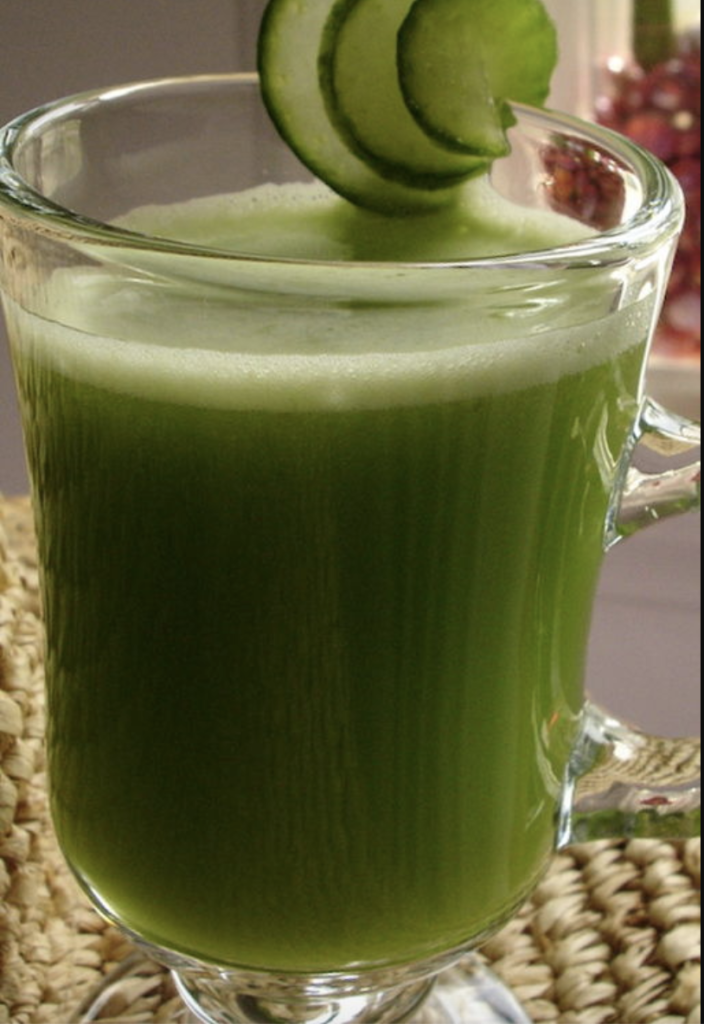
A single glass of juice can pack the vitamins and minerals from several pieces of fruit and vegetable into one drink. People who tend to get most of their calories from meat, potatoes, bread, pasta and carbs often don’t get enough fruits and veggies and their micronutrients, and juicing can help address that problem.
When you use a good juicer, you remove much of the dietary fiber that comes from plants. Dietary fiber is very important to good health. Eating fruit without fiber might also negatively affect the way your body absorbs the sugars in the juice.
The more fruit and high-sugar vegetables (e.g., carrots and beets) you eat, the more sugar you ingest. Sugar stimulates the production of LDL particles, which transport bad (LDL) cholesterol into your arteries, increasing your risk for heart disease. Too much sugar can also increase your risk for Type 2 diabetes.
A glass of juiced apples contains many more calories than what you get from eating one apple. Do some research before you start juicing so you know how many calories you get from each glass you drink.
Homemade juice isn’t pasteurized, which is a low heating process that kills bacteria. Drinking unpasteurized juice can lead to a higher risk of food illnesses, especially if you store your juice for later drinking.
To get the most juice out of every piece of fruit of vegetable, you won’t be able to use your current blender or food processor. The best juicers can cost hundreds of dollars. However, the investment can pay for itself many times over in improved health and decreased health care costs, if you follow a sensible juicing plan.
Additional Information
Mayo Clinic: Is juicing healthier than eating whole fruits or vegetables?
Vegetarians don’t have to miss out on the fun of eating comfort foods they grew up with. If you’re not a vegetarian, but just want to reduce your meat, fish or fowl consumption, you can still eat many of your favorites by making a few substitutions.
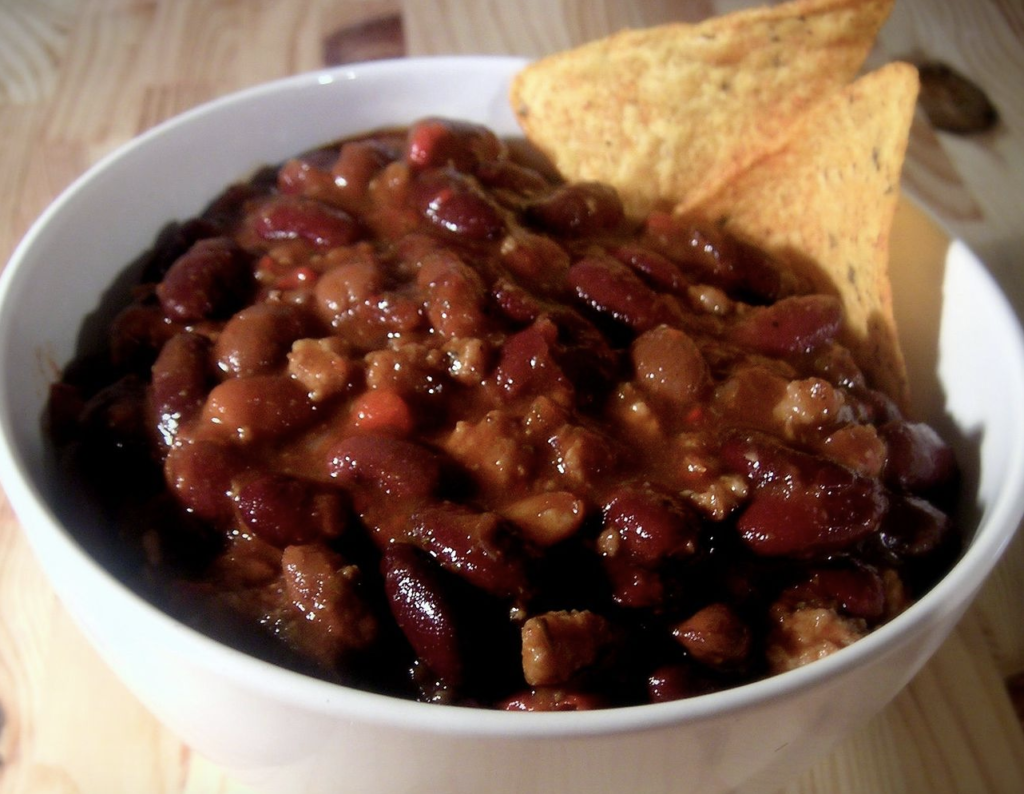
Kick up your mac and cheese with some tarragon, sliced cherry tomatoes and red and green peppers and onions. The tarragon takes mac and cheese to a grown-up flavor level, with the tomatoes adding acid and the baked onions and peppers adding sweetness. Add unique cheeses to make your mac stand out from the crowd and make sure to top it with toasted breadcrumbs. Let the mac and cheese cool and cut it into squares, like a lasagna. Serve it as a main dish after a cup of soup and a side salad.
OK, technically, chili doesn’t have beans, but vegetarians need protein sources and adding kidney or pinto or black beans to chili is a no-brainer. Make your chili as spicy, mild or sweet as you like, but be sure to dice your veggies in large pieces so you don’t lose the flavor of each. Add some corn bread with whole corn kernels to serve with your chili, or use old standbys like saltines or oyster crackers.
Thick, meaty Portobello mushrooms, sautéed and served with your favorite bun and toppings will make you forget to ask, “Where’s the beef.” Experiment with different marinades or sauces for your mushroom “patty,” and moist lettuce, tomatoes, caramelized onions, along with a slice of gourmet cheese. Serve with sweet potato fries and your favorite beverage and you’ll have your meat-eating friends asking for the recipe.
With one or two substitutions, you can turn a peanut butter and jelly sandwich into a healthier main dish vegetarians will love. Peanut butter is high in calories, but that means you don’t need a lot to create a satisfying sandwich. It’s also a good source of protein and healthy fats.
If you want a healthier alternative, try almond butter. OK, so jelly isn’t health food, but we’re talking comfort food here! Find the most natural brand you can to lower the sugar content.
To take this sandwich to the next level, slice some bananas and add them to the nut butter and jelly, then grill an interesting bread choice or a Flatout flatbread. Serve with a cup of veggie soup and some sliced carrots or celery and you’ll feel like mom just made your lunch.
There’s so much going on in lasagna you’ll never miss the hamburger in a vegetarian version. To make a lasagna primavera, dice bell peppers, mushroom, broccoli, onions, carrots, celery or any of your other favorite veggies into large pieces. These should be the stars of your lasagna. Look for a vegan or whole grain pasta and choose a healthy, natural cheese.
You should be able to find plenty of red rice and beans (a complete protein) kits in your grocery store, which are usually sold as a side dish. To make this your main dish, add your favorite veggies – try whole baby carrots as a substitute for chicken or sausage. They add some crunch and sweetness as well as extra vitamins and minerals. Take some instant corn bread mix and add some canned corn kernels, along with chili powder, for a great accompaniment.
Using a flatbread, English muffin, hard roll or bagel, you can have pizza anytime. Keep some healthy tomato sauce in the fridge, some of your favorite cheese, and a few veggies, and you’re only minutes away from a pizza party. No tomato sauce? No problem.
Try a white pizza with some olive oil drizzled on your crust, then topped with shredded or crumbled cheese, olives, spinach, mushrooms or your other favorites.
It’s a long time to go without eating anything between lunch and dinner for active kids. A healthy, tasty after-school snack is the perfect way to help kids keep their blood sugar levels better regulated, provide them the fuel they need for their activities, and prevent the dinnertime hunger that leads to overeating.

Combine favorites like apples and cheese, berries and cottage cheese or pears and string cheese. Fruit and cheese provides a good balance of carbs and protein, gives your kids a natural sugar source and provides your child important micronutrients, such as vitamin C, potassium and antioxidants.
Serve moist, crunchy, tasty veggie wraps with Flatout flatbread stuffed with a variety of items like romaine lettuce, shredded carrots, sliced radishes, avocado wedges, sliced tomatoes or any other veggies your kids love. Add a bit of creamy, low-fat dressing or some shredded cheese for protein.
Make a Tex-Mex treat with tacos filled with shredded lettuce and cheese, diced tomatoes and onions, guacamole and salsa. For a burrito, add some refried beans and Mexican rice.
Everyone knows that kids love peanut butter. Fortunately, it’s also a good source of protein and healthy fats. Have your kids try other nut butters, including almond butter, which provides more nutrients than peanut butter.
Almond butter has more dietary fiber, minerals, vitamin E and healthy fats than peanut butter, and is also a great choice for kids who have peanut allergies (check with your doctor first to make sure other nuts are OK if your child has a peanut allergy). Serve nut butters with baked, whole grain crackers. If you don’t have crackers, spread some nut butter on apple or celery slices.
Chewy, crunchy, salty, sweet – what more can you ask for in a snack? Combine a variety of nuts, dried fruit, chocolate pieces, popcorn, broken baked pretzels and other goodies to make a healthy trail mix. Avoid ingredients made with processed sugar and carbs. Dried apricots, cranberries, dates and grape (aka raisins) add sweet chewiness to trail mix. A healthy granola bar with a glass of milk provides plenty of calories, carbs, protein, vitamins and minerals.
A sweet, creamy cup of yogurt with some crushed walnuts or almonds is a tasty, crunchy, filling treat for kids on the go. Read the label on yogurt cups to avoid excess sugar and processed ingredients.
Fruit drinks are packed with sugar, even 100 percent juice and all-natural brands. That’s because fruit has natural sucrose (which makes it sweet). Buy healthy fruit juices but give your kids small servings, or dilute the juice with water. Definitely avoid sports drinks – kids don’t need them if they are not sweating during long sports activities.
You’ve probably heard the term “Super Foods” recently, but what exactly are they? Super Foods are high-nutrition carbs, proteins and fats packed with more vitamins, minerals, fiber, Omega 3 fats, lean protein and/or other nutrients than most foods in their categories. Boost your health this year by including more of these nutrient-dense foods to your meals and snacks.
All fish aren’t healthy, especially the types you typically find in casual dining restaurants such as tilapia and catfish. Salmon is a high-fat fish, but it contains the good fat that provides many health benefits – Omega-3 fatty acids.
Omega-3 helps promote heart, vision and joint health, may improve brain function and can reduce the effects of inflammation. Salmon is also a rich source of lean protein and can be poached, broiled, sautéed or steamed for a healthy dish.
Very few foods contain natural vitamin D (although many foods are vitamin D fortified); salmon contains more than 100 percent of your recommended daily allowance of vitamin D, as well as vitamin B12. Salmon also provides more than half your RDA of several other nutrients.
Other coldwater fish that are good sources of Omega 3 and lean protein include tuna, mackerel, sardines, halibut, cod and trout. Choose wild-caught salmon instead of farm raised for the healthiest fish.
If you’re served farm-raised fish, remove the skin, which is where fish process toxins and other impurities. Look for light tuna instead of albacore (chunk light and solid or chunk white), which contains up to three times more mercury.
Nuts and seeds are wonderful sources of lean protein, healthy fats, vitamin minerals and dietary fiber. Keep a jar of seeds on your kitchen counter and sprinkle them on salads, into stir-frys, onto desserts and into soups. Nuts are calorie dense, so control your serving sizes.
A handful of nuts with a glass of water makes a healthy mid-morning or afternoon snack of between 100 and 150 calories. Limit servings of peanut butter to around 2 tablespoons, which still comes in at almost 200 calories.
Despite what low-carb and gluten-free proponents claim, whole grains are a healthy source of nutrition if you eat the right kinds and in the right amounts.
Like their tasty white counterparts, orange and purple (on the inside) sweet potatoes are a rich source of complex carbohydrates; however sweet potatoes are also packed with antioxidants, beta carotene, vitamins C and A, several B vitamins, manganese, copper, phosphorus and potassium.
The skins provide a great source of dietary fiber. Don’t feel guilty about adding some butter or olive oil to your sweet potatoes. Some researchers believe that fat served with sweet potatoes increases the intake of the beta-carotene into your body.
Eating a handful of blueberries is like taking a supplement, according to fans of this sweet tasty berry. Blueberries are a good source of fiber, antioxidants and phytochemicals known as flavonoids.
There’s no definitive research on how helpful flavonoids are, but proponents believe they help reduce the impacts of inflammation and allergies, battle heart disease, memory loss, poor vision and cancer, and promote gut health, among other benefits. Blueberries also provide a good dose of vitamins C and K, manganese and copper, and are a low-sugar berry.
You’re probably hearing more and more about kale, which is a leafy green vegetable like spinach or lettuce. Kale provides lots of vitamins C, A and K, provides antioxidants and phytochemicals, and a wide variety of minerals.
It’s also a very good source of dietary fiber. Kale is less researched than other super foods, but the vegetable’s fans say it’s an ideal food to add to your diet to help with “detoxing” your system, and it can improve blood cholesterol and heart health.
It’s a favorite green to add to juicing recipes. Experiment with different varieties of kale, which can taste peppery, sweet, mild or bitter.
Beans are another rich source of lean proteins, are low in “bad fats” and are a good way to get dietary fiber. They can make soups, salads, pastas, stir-frys and stews more filling and reduce the amount of meat or fish you need to satisfy your protein craving.
Healthy yogurt (not the kinds loaded with sugar) is a good source of protein and healthy fats, and helps with gut health. Gut health is now recognized as something people should be paying more attention to because your intestines are the gateway to the rest of your body and play a significant role in your overall health.
Yogurt contains probiotics, which are microorganisms that help with digestion and gut health. Other easy to find sources of probiotics include pickles and sauerkraut.
You almost can’t eat too much oatmeal! It’s a great source of dietary fiber, a slow-digesting complex carbohydrate, a non-fat source of nutrition and can help with a variety of health issues, including colon cancer and cholesterol.
Avoid the little packets flavored with brown sugar, cinnamon, raisins or apples. If you read the nutrition label on those boxes, they contain a load of sugar. Opt for a box of steel cut or rolled oats.
These refrigerator staples can be served so many different ways there’s no excuse not to eat them more often. In addition to providing dietary fiber, they also contain high amounts of vitamins and minerals. Spinach is a favorite go-to green for juicing fans, and it’s a healthier substitute for lettuce on your sandwiches and in salads.
Broccoli is healthiest when it’s steamed, lightly microwaved or eaten raw. Avoid boiling spinach and pouring the water down the drain.
Once maligned because of their high dietary cholesterol content, eggs are now recommended as a protein-packed food with healthy fats and other nutrients. Now that dietary cholesterol has been found not to contribute to heart disease, add more eggs to your weekly diet.
This green fruit is fairly common in grocery stores and looks like a typical seeded citrus fruit when you cut into it. It won’t be an unusual or acquired taste– you can start enjoying this succulent treat without having to get used to it because it’s so sweet and mild.
It’s packed with vitamins and minerals, especially potassium, which makes it a better alternative to bananas if you’re an athlete who needs a post-workout electrolyte replenishment. It’s packed with vitamin C and antioxidants and contains serotonin, which can help promote better sleep.
Garlic not only wards off vampires, it can also help ward off unhealthful bacteria that can cause viruses and infections. Garlic might also help prevent or reduce the effects of a cold, inflammation, high blood pressure, heart attack, stroke and poor blood cholesterol.
Garlic is a good source of vitamin C and antioxidants. There’s not enough evidence to support taking garlic as a supplement, but adding more to your diet will add both flavor and nutrition to your meals.
After you crush or cut fresh garlic, let it sit for 10 or more minutes. This will help activate and convert enzymes that provide healthy benefits. Microwaving or heating whole cloves can suppress these enzymes. So, if you’re cooking with fresh garlic, make cutting or crushing it your first prep task.
You don’t need a big back yard or lots of equipment to start your first garden and begin growing your own fresh fruits and vegetables. You can even start gardening if you live in an apartment or condo.
It’s actually better to start small your first year to get a feel for what gardening is all about. Follow these tips to be successful with your first garden, which can grow into a fun hobby, a way to cut your grocery bills and big step toward eating healthy for many years to come.

Take a few days to determine where your yard will have the most sunlight. For most fruits and vegetables, you’ll need at least eight hours of direct sunlight on the plants for the best results. This means you might not be able to start a garden in your backyard if there’s not enough sunlight. Six hours might be enough for some plants, but you might not get the biggest tomatoes, eggplants or zucchini.
Many municipalities won’t let you situate a fenced-in garden in your front yard, but you can spread plants around the perimeter. Since you’ll be starting your first garden with only a half a dozen plants or less, look for several areas around your front yard where you can plant vegetables and fruits in a container and let them grow tall with the support of a stake or two.
It’s easy to learn which plants will grow best in your locale and what time of year to plant them with a quick Google search. For example, okra requires high temperatures and will grow better down south than up north. Cabbage needs cooler temperatures and is a fall plant.
Some vegetables grow under the ground, such as carrots, radishes, beets, onions and potatoes and you won’t need to worry about their height. Other fruits and berries, such a tomatoes, zucchini, eggplant, squash, strawberries raspberries and peppers, grow on vines above ground. Where you plant (e.g., windowsill, balcony, deck or flat land) will dictate what types of plants you should choose.
You can start plants from seed indoors in small cups if you want to get a head start before the growing season. Even if you wait until spring and buy your fruits and veggies from a garden center as small plants, they’ll be cheap (less than $5 each). YouTube has many videos that will show you how to start plants from seeds inside your home.
Bees help pollinate your plants, so put some flowers around your garden to attract these helpful workers. Ask your local gardening store expert for recommendations for several flowers to make sure you have blooms spring, summer and fall.
You don’t need land to plant a garden. Container gardens are popular for urban dwellers or those just getting started. Containers work well on decks, patios, balconies, porches, rooftops and window ledges. You can buy pots at a garden store or use containers you have around the house. You can even start a garden inside a wheelbarrow. Containers let you create a portable garden that you can move once each day to maximize plant’s time in the sun.
Depending on where you live, you might have soil that’s not well suited for growing fruits and vegetables. Your local garden store experts can help you determine if you can stick plants directly into the ground at your house, or if you’ll need topsoil, lime or other items to prepare your planting area. Turn up some soil in your yard, take a pic on your cell phone and bring it to your home and garden center (along with a baggie a soil sample) for free, expert advice.
If you’re planting in the ground, plan on using a spade, hoe, wheelbarrow and hose. If you’re committed to a large garden, you might want to rent a rototiller to prep your soil. Purchase some fencing and growing stakes to keep plants upright as they grow and bear fruit.
You don’t need to water your plants every day. Once or twice a week is enough if the watering is deep enough. Keep an eye on weeds and pests and look for online tips to keep insects from eating more of your fruits and veggies than you do. For example, putting coffee grounds around your plants can keep some pests away (they don’t like the smell).
Know when to harvest your fruits and veggies, and if certain plants need pruning. This will help you grow the largest, most flavorful tomatoes, carrots, strawberries and peppers. You can find an answer to virtually any gardening question you have by typing into a search engine and including the name of your state (for more specific advice).
Nuts and seeds can provide tasty protein, dietary fiber and healthy fats to many meals and snacks. Here are a variety of ways you can add more of this nutritious powerhouse to your weekly eating.

Nuts are calorie dense, which means you don’t need that much to fill and satisfy you. Read labels on jars and packages to learn how to create snacks and servings of approximately 150 calories. Learn how a small amount of nuts or nut butter and a companion (e.g., celery, yogurt, apple slices) will affect the final calorie count. Think about adding only one tablespoon and some honey to a single slice of bread for a filling sandwich to go with your soup.
Nuts add more protein, healthy fat and crunch to your salads, which will leave you more satisfied than if you just eat water-based veggies and toasted bread.
Nuts can change the texture of a stir-fry and reduce your need for beef, chicken, pork or seafood.
Tired of or allergic to peanut butter? Make almond butter your next choice. If you like that, experiment with cashew and other nut butters. Beware of the sugar in Nutella, though.
Many yogurts rely on sugar to take away the bitter taste. A few crushed nuts in more natural, low-sugar yogurts will make the snack less boring and more satisfying.
Muffins, brownies, cakes, pies and other baked desserts all taste great with nuts.
Cashews or crushed walnuts add great flavor and more nutrition to meaty or vegetarian stews, chilis or curry dishes.
Crunchy nuts cooked with roasted, savory pork, beef or chicken and the vegetables that have been cooked with them, add a unique aspect to roasts.
Spread some nut butter on apples, pears, celery or carrots for a quick, satisfying combination of protein and carbs.
Don’t forget to add nuts to smoothies. You can include them when you start mixing the ingredients if you want to drink it with a straw, or add them toward the end if you want some crunch in a thicker, spoon-eaten drink.
Nuts are great way to replace greasy hamburger or sausage in a marinara sauce. Authentic pesto sauce requires pine nuts, but you can substitute any healthy nut for a delicious pasta topping. You can also skip the sauce and sprinkle in some crushed nuts into pasta tossed with olive oil, garlic, salt and pepper.
Create your own 100- to 150-calorie snack packs using sandwich bags. Add dried fruit and/or some bits of chocolate for a trail mix.
What’s an easier way to jazz up a limp can or green beans than with some slivered almonds?
Keep a nut grinder on hand to let you turn nuts into a powder you add to your favorite low-fat (or any) soups for more body and flavor.
Keep a can of unsalted mixed nuts and individual snack packs you buy in grocery store around the house and in your desk at work.
The Farm-to-Table movement is growing across the country, allowing local residents to eat healthy, delicious foods grown in their own areas. With a little planning, you can join the movement and help support your local farmers while tasting the bounty your hometown region has to offer.
The easiest way to begin eating farm to table is to find your local farmer’s markets. In some communities, the town government organizes farmer’s markets where local producers set up stalls and sell their goods. Your shopping might be limited to one day a week when this happens.

You can also look for a commercial farmer’s market that’s open all week, similar to a grocery store. In addition to fresh fruits and vegetables, these markets also sell meats, fish and poultry, and healthy packaged and convenience items from out of the area.
Join a Community Supported Agriculture group to get first shot at local produce and lower prices. With a CSA, you pay a fee in advance to help local producers fund their operations. You then get fresh food as it’s harvested. By cutting out the middleman, you pay a few hundred dollars for much more than that amount in food, compared to what you’d pay for the same amount at the grocery store.
Look for restaurants in your areas that source local produce and proteins and check out their menus. You’ll not only support local farmers, but also meet like-minded people and pick up ideas for ingredients to add to your pantry and dishes you can start making at home.
Plan a few seasonal menus based on your area’s harvests. Write a list of side dishes you can pair with a variety of proteins throughout the year. Thanks to sites like YouTube, you can find step-by-step demonstrations for making almost any dish online.
Just type in the name of an ingredient or a dish and you’ll likely find multiple recipes and demonstration videos. For more options, visit sites like FoodTV.com to find scads of recipes and photos from your favorite celebrity chefs. And don’t forget to surf the Flatout blog for many great recipe ideas.
You don’t need a large backyard, lots of equipment and years of experience to grow at least some of your own food. You can start with a small container garden or try your hand at growing just a few of your favorite veggies in your backyard.
Go online and research your USDA Zone to find out what fruits and vegetables will grow best in your area and when to plant. Ask for help at your local farmer’s market or send an email to your friends asking who gardens – you’ll get lots of helpful tips.
Children are more likely to want to eat healthy if they are part of the process of buying the family food, planning menus and cooking meals. Plan a field trip to a local farm, dairy or orchard and let kids meet the people who grow their food. Take them to the farmer’s market or grocery store for short trips and teach them how to shop.
Plan a meal based around local ingredients and teach your young Emeril or Rachel Ray how to make the dishes.
Blast email your friends to find out who cooks, likes entertaining, and is interested in starting a progressive Farm to Table dining group. It might be just a few times per year or a monthly get-together to try new foods, sample interesting wines and enjoy great conversation.
Proponents of garlic claim it can help do everything from prevent cancer and lower blood pressure to strengthen bones and prevent heart attacks. While some studies suggest links between taking garlic and preventing and treating a host of disease and conditions, there are few widely accepted studies to support any one claim.

Understanding what some of the benefits of garlic might be will help you decide if you want to add more fresh garlic or a garlic supplement to your cooking, diet and healthy living goals.
Here are eight possible benefits of garlic (depending on how much and what type you take).
The flavor “trinity” used by food makers to sell products consists of sugar, fat and salt – all things we love in our snacks and meals. Garlic is a flavorful alternative for kicking up dishes, and it’s low in calories.
At higher doses, garlic can help the circulatory system and reduce blood pressure. Talk to a doctor about taking a garlic supplement if you have high blood pressure or hypertension (persistent high blood pressure).
Garlic can help reduce two of the four cholesterol measures you get when you have a blood screen. While it doesn’t lower triglycerides or raise HDL (“good”) cholesterol, it can help lower total cholesterol and LDL (“bad”) cholesterol.
Garlic is a good source of manganese, vitamin B and vitamin C, and contains other vitamins and minerals, including calcium selenium, phosphorus, iron and potassium.
More and more health problems are being traced to inflammation, including the effects of flu, hangovers and indigestion. Some of the nutrients in garlic boost the immune system and help reduce inflammation, helping you combat aches and pains that occur for a variety of reasons.
Recent research suggests that it’s inflammation, not acid, that causes “acid” reflux. It makes sense then that garlic, long thought to aid digestion, does so because of its anti-inflammatory effects. On the other hand, too much garlic can cause heartburn in some people, so be careful about how much you put in your dishes until you see how you react.
Garlic is known to help keep fleas and ticks off pets when put into a cat’s or dog’s food. The bugs taste the garlic in the pooch’s or kitty’s blood, don’t like it, and then tell the rest of their flea or tick family not to bother that pet. Eating garlic or rubbing it on your skin might help prevent mosquito bites (although your friends won’t want to sit next to you while you smell like a vampire hunter).
Taking a garlic supplement can help boost the immune system and help prevent or reduce the effects of a cold. This is one of the more documented health benefits of garlic.
Just kidding…Or am I?
•Roast it – spread roasted garlic on some crusty, olive oil-drizzled bread for an awesome garlic bread.
•Season with it – experiment with some of your favorite dishes by adding just a bit of freshly chopped garlic, then adding more until you find the right flavor profile.
•Add it – to salsa, guacamole, mashed potatoes, eggs, stews, roasts, pasta sauce, stir fry’s and other savory dishes.
•Pause – don’t chop garlic and then immediately heat it. Some of garlics’ healthiest nutrients remain separate in the cloves. When you cut and mash garlic, these nutrients mingle and form a health-giving compound. If you immediately heat garlic after cutting it, this doesn’t give the nutrients time start working together. You also don’t want to overcook garlic, especially by burning it by adding it to hot oil at the beginning of cooking a dish.
•Take a garlic supplement—talk to a registered dietitian to make sure you buy the right type of garlic supplement and avoid expensive pills that promise lots but offer little.